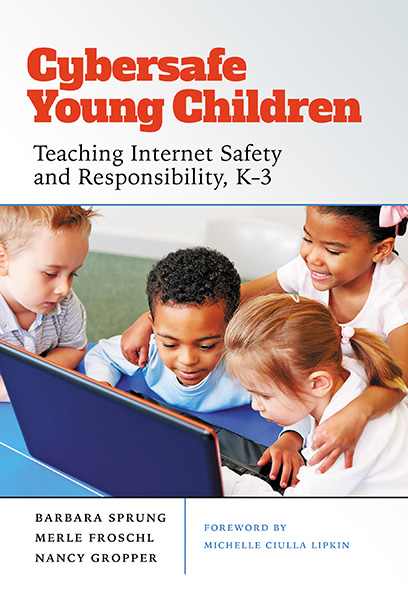Professors: Request an Exam Copy
Print copies available for US orders only. For orders outside the US, see our international distributors.
Barbara Sprung, Merle Froschl, Nancy Gropper
Foreword by: Michelle Ciulla Lipkin
Publication Date: March 27, 2020
Pages: 128

Learn how to integrate lessons about good digital citizenship into the daily life of the early childhood classroom. Based on reviews of empirical research, this book addresses the need for a new educational paradigm that will enable educators to help young children develop the skills and ethical behaviors they will need to thrive in both the real and digital worlds. Cybersafe Young Children provides a rationale for addressing issues of cyber safety and children’s usage of social media in the early grades to prevent later harmful behavior, such as cyberbullying. Written from a developmental perspective, it offers practical classroom strategies for fostering positive digital citizenship in young children.
Book Features:
Barbara Sprung has over 40 years of experience in early childhood education as a teacher and innovator. Merle Froschl is director of Educational Equity at FHI 360. Nancy Gropper is former associate dean for academic affairs (now retired) at Bank Street Graduate School of Education. They are coauthors of Supporting Boys' Learning: Strategies for Teacher Practice, Pre-K–Grade 3.
“We are finally learning that education around media and technology is a life-long process and not something we can wait to start teaching until a child is ‘old enough’…. Cybersafe Young Children builds a strong case for early education around digital citizenship and cyberbullying. It outlines a practical plan for early intervention and skill building. It provides a roadmap and resources for those who work with and support K–3 students.”
—From the Foreword by Michelle Ciulla Lipkin, executive director, National Association for Media Literacy Education
“For young children to be Cybersafe, their parents, caregivers, family members, teachers, and teacher educators need to embrace the developmentally-informed knowledge, skills, and evidence-based strategies found in these pages. With guidance from well-prepared media mentors, young children can learn to safely and mindfully use digital devices at home and in school as powerful tools for their learning, social-emotional development, communication, and collaboration to become effective digital citizens in their real and digital worlds.”
— Chip Donohue, principal, Donohue and Associates, founding director, Technology in Early Childhood (TEC) Center at Erikson Institute, senior fellow and advisor, Fred Rogers Center
“This book has arrived in the nick of time! Educators (and parents) now have a go-to guide for activities and strategies that are research-based, playful, and in tune with the needs of young children in the Digital Age. This book literally provides a map for helping our society get to a safer and more just world, online and off.”
— Lisa Guernsey, director, Teaching, Learning, and Tech Program, New America
Contents
Foreword Michelle Ciulla Lipkin ix
Acknowledgments xi
Preface xiii
Purpose xiii
Background xiii
Technology and Young Children xiv
What You Will Find in This Book xv
Introduction 1
The Case for Starting Early 2
A Focus on Development and Experiential Learning in Grades K–3 4
Part I: Premise
1. What the Research Tells Us: Preteens and Teenagers in the Digital Age 9
Gender Concerns 10
Cyberbullying, Self-Harm, and Suicide 12
Summary 13
2. Digital Citizenship and Cybersafety: A Priority Early Education Concern 15
Summary 19
3. Cyberbullying Bystanders: Active and Passive Responses 21
Summary 23
4. Preventing Cyberbullying: A Social–Emotional Perspective 25
Social–Emotional Profile of Children in K–3 26
Early Childhood Practice in Support of Social–Emotional Development 27
The Social–Emotional Risks If Cyberbullying Is Not Addressed 28
Summary 28
Recommended Readings 29
Part II: Practice
5. Implications for Teacher Education 33
Familiarity with Federal and State Mandates 33
Incorporating the Issue of Cyberbullying into Education Course Content 34
6. Message for Teachers and Administrators 37
Summary 40
7. A Curriculum Map for Good Digital Citizenship 41
Gathering Information at the Beginning of the School Year 43
Establish Classroom Rules 44
Conduct Activities to Provide or Refresh Shared Language About Face-to-Face Teasing and Bullying 45
Conduct Classroom Discussions About Digital Technology and Social Media 45
Establish Classroom Rules and Provide Direct Experiences About the Meaning of Good Digital Citizenship 46
Part III: Classroom Activities
Introduction to Activities 49
Activity #1: Discovering What We Know 51
Activity #2: Creating Rules for Good Digital Citizenship 53
Activity #3: Word Webs and Charts: Building Vocabulary for Digital Citizenship 56
Activity #4: Doing the Right Thing: A Form of Courage 59
Activity #5: What Does Permanent Mean? A Word Experiment 63
Activity #6: Understanding Privacy: An Important Concept for Online Activities 65
Activity #7: Building Good Digital Citizenship 68
Activity #8: Working with Partners 70
Part IV: Resources
Picture Books About Face-to-Face Teasing and Bullying 75
Children’s Books About Online Safety and Cyberbullying Prevention 79
Organizational Resources 81
Appendix A: School Statement 87
Appendix B: Letter from Computer Teacher 91
Appendix C: Parent Letter and Questionnaire 93
Appendix D: Glossary 95
References 97
Index 101
About the Authors 108
Professors: Request an Exam Copy
Print copies available for US orders only. For orders outside the US, see our international distributors.